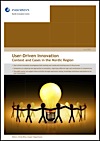User-driven innovation in the Nordic region
The 137 page report describes in detail what user-driven innovation actually is, outlines the current state of affairs in each of the five countries (Denmark, Finland, Iceland, Norway, and Sweden), showcases what companies are doing through a number of case studies, and sets out what the public sector can do to support these activities.
The case studies in particular describe some of the most important companies in the region, including Danfoss and DSB in Denmark, Outotec in Finland, CCP in Iceland, Tine in Norway, and Electrolux in Sweden.
Interestingly, the report also features two international company cases to illustrate non-Nordic examples of systematic user-involvement in concept innovation: Intel and Valve.
Abstract
The nature of innovation is changing. An increasingly globalized society, enabled by information and communication technologies (ICT), has changed the process of value creation and shifted the balance of power between firms and individual consumers – or users. Companies can no longer rely solely on operational efficiency or technological superiority in order to create a competitive advantage.
Today, companies must also find ways to define and deliver unique experiences, together with users, in order to survive. However, this requires a paradigm shift – both a change in mindset and adjustments to current working practices.
In this report, the process of defining unique experiences together with users is referred to as user-driven innovation. User-driven innovation encompasses both an understanding of true user needs and a systematic involvement of users in the innovation process.
The report explains a number of market forces and academic underpinnings, and presents an overview of the context regarding user-driven innovation in each of the five Nordic countries. The report also presents concrete examples of how companies employ user-driven innovation processes.
Finally, the report suggests a number of policy-level activities which could be undertaken to strengthen both the understanding and practical competencies related to user-driven innovation.





[…] Via the Experentia blog: […]
[…] Via the Experentia blog: […]
[…] | Putting People First @Experientia p.7 [↸] p.7 [↸] p.15 […]